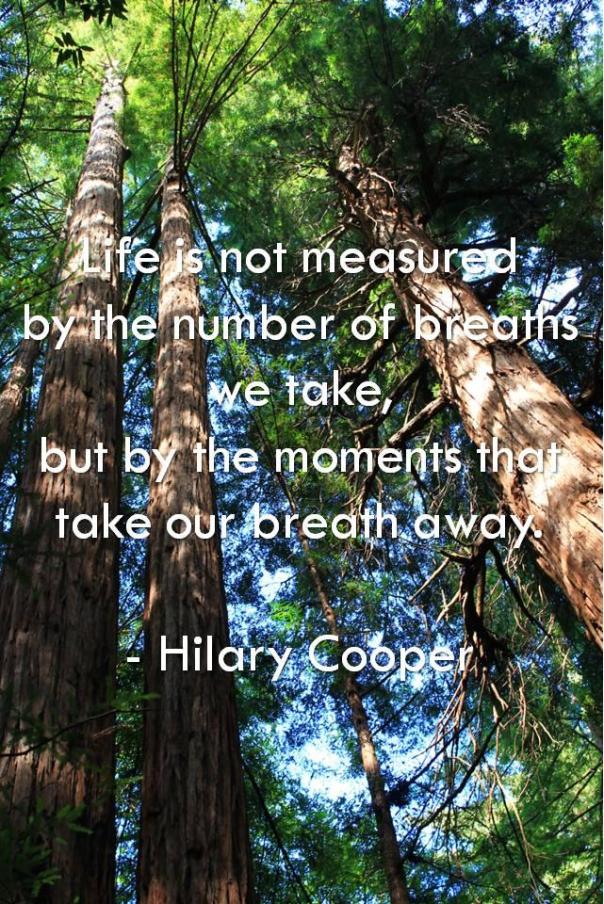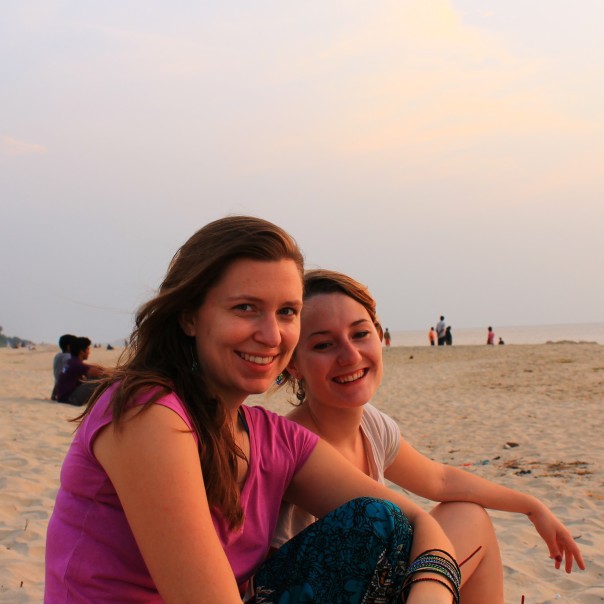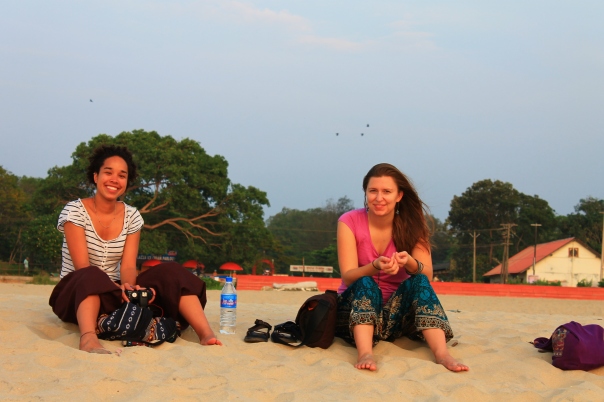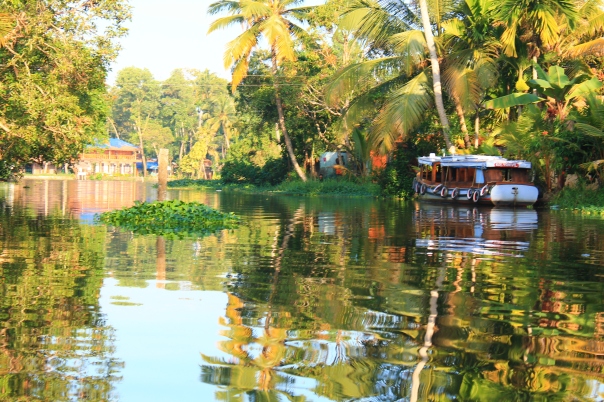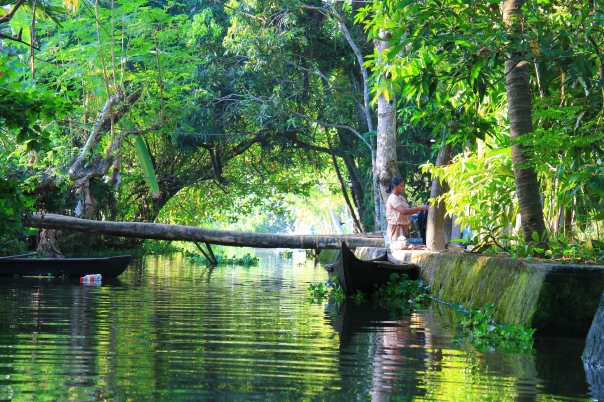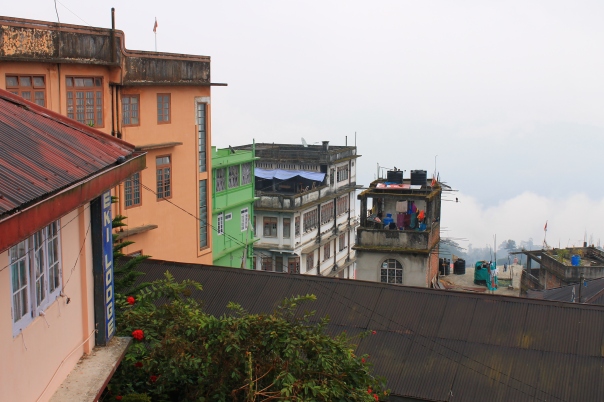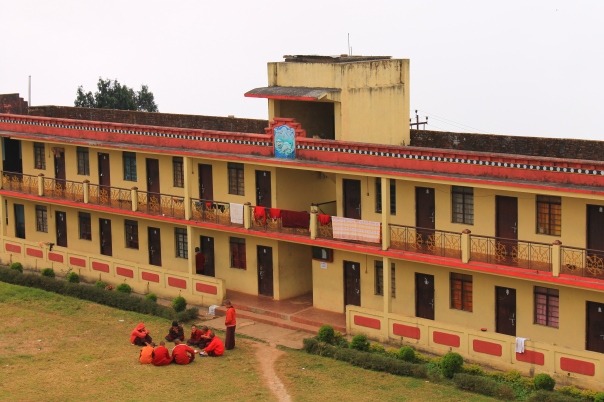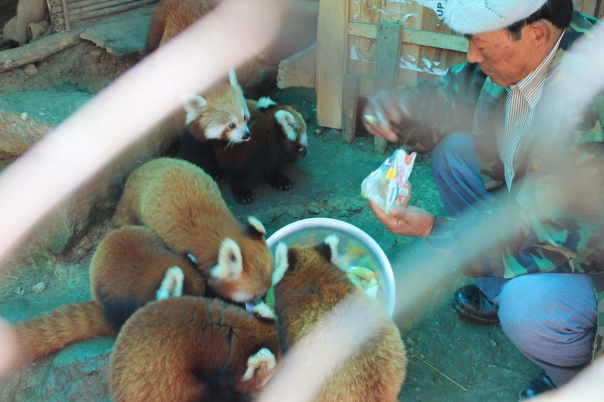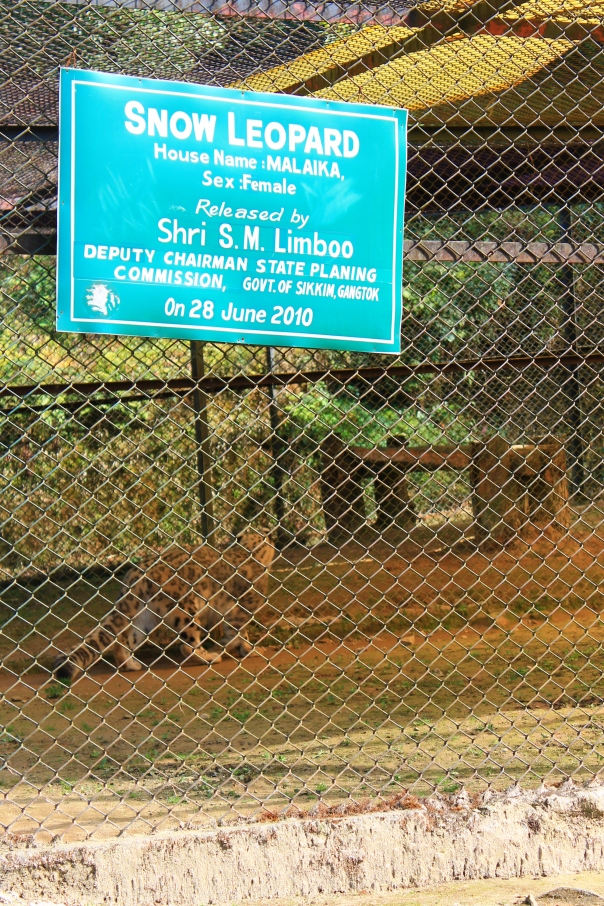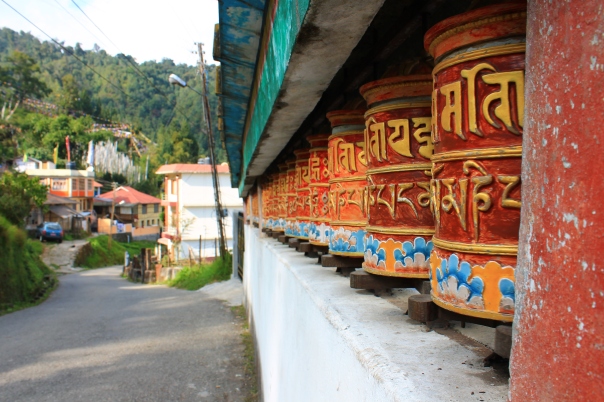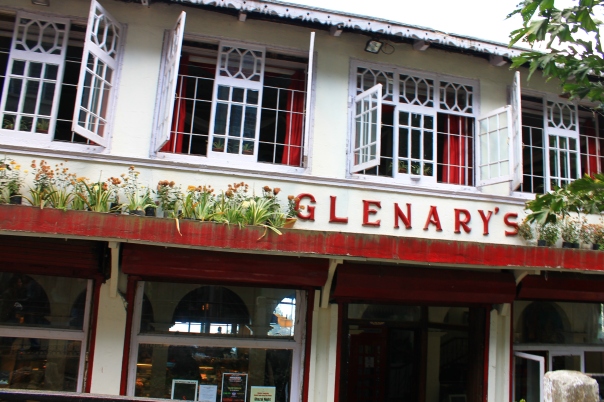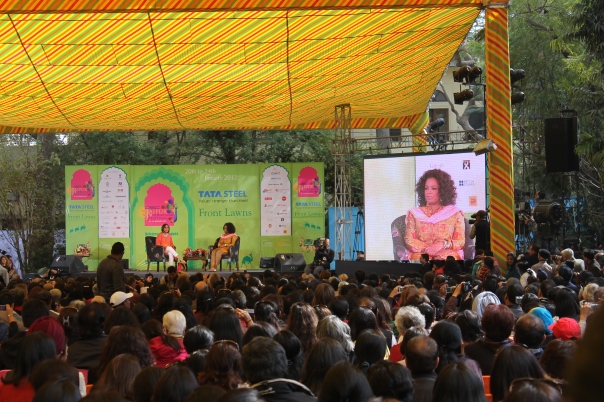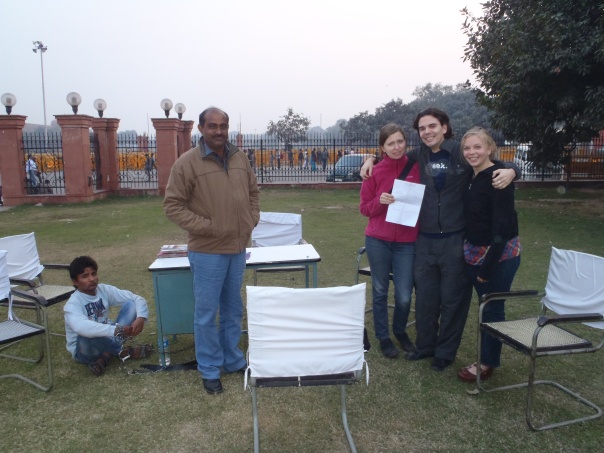Live an Extraordinary Life!
For purposes of this blog post I attempted to calculate the number of miles I traveled in the past thirteen months since I left home for New Delhi. I made a spreadsheet and did my best to remember each trip I took in the past year and a month. By the time I had documented each flight, each connection, each weekend bus trip, I had reached Row 86.
There is a cheesy quote that you can find in most travel books and even though it is a bit overused it still has an impact on me.
Life is not measured by the number of breaths we take, but by the moments that take our breath away.
– Hilary Cooper
To me, the quote is a reminder to live an extraordinary life. Extraordinary means something different for each of us. I used to be confused by the word extraordinary. How could extra ordinary be synonymous with outstanding? It seemed like a contradiction. Then I looked it up and realized the extra does not mean “super” ordinary, but rather “out of” or “beyond”. Living an extraordinary life means living in a way that is remarkable (worth talking about) or surprising. It means living in a way that shakes things up once and awhile; keeps you on your toes and interested in staying present to the string of moments that is your life.
As the quote suggests, not every moment is extraordinary – we wouldn’t be able to breathe! But if ever so often you seek those moments of breathlessness, of awe, of spellbinding joy, you will find, at the end of your days, that you have lived an extraordinary life. Extraordinary also seems to me like a naturally balanced word. You must spend enough time cultivating your own unique version of ordinary in order to know what lies beyond. To live in a way that is extraordinary we must know our own comfort zone and explore our edges.
To me extraordinary means getting to know and understand the human family in as much of its diversity as I can experience in a lifetime.
Since I left home last July I have taken planes, trains, and automobiles. I have traveled by tuk tuk, rickshaw, camel cart, and my own two feet. I reconnected with dear friends I hadn’t seen in years and built new friendships with people I hope to know for the rest of my life. I visited eleven countries I had never seen before, drove through ten of the fifty states and the District of Columbia. I visited temples, mosques, churches, and gurdwaras. I tried new foods like South Indian dosas, authentic Turkish kebab, Tibetan momos, a full Irish breakfast, haggis in Scotland, and Bosnia’s traditional fast food chevapi.
On Monday I returned home to Minnesota and for the first time in thirteen months I do not have a trip planned in the near future. I don’t have a plane or bus ticket purchased and there are no road trips on my schedule. Traveling became my ordinary so now it is time to switch things up a bit and do something different – for me at least – which is to stay in one place for a while.
Fall is my favorite season and as summer fades into autumn here in Minnesota I am looking forward to pausing, grounding, and hibernating a bit – which is pretty much what I have been doing since I got home on Monday. The thing about extraordinary is that it is not always easy or comfortable. The moments that take your breath away sometimes knock the wind out of you.
Needless to say, I have not finished the mileage count, but I’ll leave that for another day when I make my own Mastercard commercial. For now I will focus on reconnecting with friends and family, drinking plenty of apple cider, and carving a pumpkin or two. I will also be documenting the second half of my time in India, the month I spent in Europe en route to the States, the travel I’ve done within the U.S. since I got home in June, as well as my current goings on. So the blogging continues!
Thank you all, dear readers, for your attention and interest as I have shared my adventure over the past year. I’m not going anywhere for a while…and I hope you’re not either 🙂
Yours,
Anna
Chardi Kala – Sikhism Explained
Sunday’s shooting at a Sikh gurdwara in Wisconsin, which resulted in seven deaths and additional injuries, hit close to home for me as many of those who hosted me during my time in India are Sikhs. I also visited the Golden Temple, the Sikhs’ holiest shrine, with my dad when he visited me during my year abroad.
Ignorance and hate motivated Sunday’s killings. In an attempt to support the healing and possibility that stem from this tragedy I have written an article for PolicyMic, an online media forum, about the Sikh faith. Education is a powerful tool in overcoming ignorance and hatred but more important is ACTION. The Sikh community is one which gives generously without being asked. I invite you to think of one thing you can do today, this week, this month, to give to someone near you. If anything I ask you to please share my article with your friends, family, and social networks.
I hope you learn something from this piece and I look forward to your feedback. Act for peace. Be love.
Click this link or paste the following into your browser: http://www.policymic.com/articles/12442/sikhism-explained-what-wade-michael-page-never-understood
For My Mom
People often asked me this year, “what do your parents think of you living in India?” The concern in their voice makes me think they picture my departure as something like a late night escape – throwing my luggage out the window, shimmying down the rain pipe, and hailing a friend waiting in a car in the alley to take me to the airport, calling home on the layover in Amsterdam to let the folks know I’m moving to India for a year. Then in January when my dad visited, people saw his interest in Indian culture and Hinduism and the question turned to an even more concerned inquiry of how my mom felt about her daughter being so far away from home in such a foreign place. How did she let you go? Well, anyone who thought she tried to hold me back for a second doesn’t know my mom.

This is a picture of my mom and me on one of my first trips to a new place. It is late September 1989, I am 13 months old and we are on a trip to visit my aunt, uncle, and cousins in Maine. My mom hasn’t aged a day since this picture (really) but I on the other hand have grown up a bit, I am taller than her now, and I while I can walk on my own I still can’t make a major decision without discussing it first with her. She never tells me what I should do but listens deeply and asks incredibly insightful questions that always lead me to the answer which is right for me. The morning I left for India last summer I woke up before dawn, terrified, thinking I was about to make a huge and scary mistake: what was I doing leaving home for so long for a place as unfamiliar as India!? I went and woke her up and she came and sat in bed with me. I don’t remember what exactly she told me but I know that when it was time for me to leave I felt strong and confident and excited to take on a big adventure.
Mom, you have been an incredible supporter, friend, and mentor as long as I can remember. You have built a strong foundation from which I can fly. Thank you for encouraging me to pursue my dreams, travel to new places, and try new things. I am inspired by your strength, your intelligence, your class and your ability to have fun and bring people together as the unrivaled Hostess with the Mostest in my book.
I think one of the greatest gifts a parent can give a child is the support and encouragement to be who they are, not what anyone else expects them to be. My parents have always encouraged me to pursue my interests and dreams and have been unwavering supporters along the way. As my year in India comes to a close (I’ll be on a plane out of Delhi in less than 36 hours) I thank them for giving me the strength and support to pursue this adventure.
I found this video a few weeks ago and it made me think of my mom. These Olympic-athletes-to-be were training from childhood so I don’t know if they devoured as many delicious homemade chocolate chips, Rice Krispie bars, hot chocolate, or Kool-Aid as I did. But, like me, they had the support of an amazing mother who was with them every step of the way, cheering them on. I dedicate this video to my mom. You are an Olympic Gold Mother if there ever was one! I miss you, I love you, and I can’t wait to see you soon.
And Happy Mothers’ Day to all of you, my readers, who are also mothers. You are rock stars!
Love,
Anna
Deep Breathing on the Backwaters – Kerala pt. 1
My last travel update ended with my awe at the view of the Himalayas from the air as I flew back to New Delhi from the Northeast. I touched down in Delhi and spent a little less than 24 hours repacking my bags for warm weather before my roommate Lesly and I hopped on a plane bound for Bangalore. We spent a couple days in Bangalore before we met up with my dear friend and fellow Bennie, Nakita, and the three of us headed south to Kerala. If God were to build the “model home” version of heaven on Earth, Kerala would be on the short list for its location. It is a paradise.
Kerala is best known for the network of meandering lakes and waterways, the backwaters, that run parallel to the Arabian Sea along the Malabar coast. Our first stop was Allepey, a small town and great place to access the backwaters. Our hotel was not far from the beach so the three of us rented bicycles and had a great time navigating the traffic on our way to the beach.
With Lesly…
…and Nakita
We enjoyed fresh coconut water, straw-in-the-coconut style of course, and watched the sun set over the Arabian Sea. The next day we woke up for a 7am canoe ride on the backwaters. As someone who grew up around lakes, rivers, and streams, I always feel more centered and in touch with what is right with the world when I am close to the water. Setting out in a large canoe that morning as mist rose off the smooth-as-glass water, not yet disturbed by the traffic of the day, I reminisced upon many similarly tranquil canoe rides with my family and friends. Though the scenery was a bit different, the bliss factor was one in the same.
As our boatman steered us through ever more breathtaking canals we saw families waking up and starting another day on the backwaters. Men and women dredged small black clam like creatures from the river bottom into long canoes. We learned that the shells are burned and used as fertilizer, a natural source of lime. Mothers and daughters rinsed dishes along the banks and washed laundry, slapping and scrubbing soapy cloth against flat smooth stones. Kids and grandparents still with the haze of sleep in their eyes brushed their teeth, standing outside the one story houses that spring up along the watery avenues.
The state of Kerala has the highest literacy rate in India at more than 90 percent and, due to sweeping and strategic economic planning by the state government, a broader than usual distribution of wealth than other Indian states. Keralans will tell you that the caste system, whose lasting legacy creates harsh disparities in other Indian states to this day, has all but disappeared from this southern paradise.
Kerala’s is heavily reliant upon tourism and local cultivation of rice and other products. Coir – the fibrous husk of the ever abundant coconut – is another important industry and I learned that all of the brown scratchy Welcome mats I’ve ever brushed my feet on probably originated in Kerala. So the next time you are brushing snow off your boots on a coconut coir mat, you can think of sunny Kerala.
After Allepey Nakita and I spent time at a homestay on the backwaters and then the three of us spent a couple days in Forth Cochin. I will dedicate a separate post to the second half of the trip. For now, I’ll leave you with this picture, one of my favorites of the trip. I brought along two of my Bennies shirts so Nakita and I could snap some pictures worthy of the alumnae magazine. Here we are in our canoe on the backwaters.
In the Clouds – Sikkim and Darjeeling
This post is the first in a series of long overdue updates documenting my travels between early December and now. At the end of my first semester in Delhi I crisscrossed the subcontinent, spent Christmas in Minnesota, and traveled with my dad for two weeks. Since January I had a visit from some colleagues/friends from MN which included three days spent in Nepal, went back to Ahmedabad and visited Udaipur, and most recently spent about a week in Istanbul, Turkey. This is an account of my first trip in the bunch.
After my first semester exams I traveled to Sikkim and Darjeeling with fellow Ambassadorial Scholar Emrys McMahon. Emrys met a Rotarian from Sikkim at a conference in Delhi and she invited us to visit and speak at their club, Rotary Club of Gangtok South. So we scheduled that and another visit to the Rotary Club of Darjeeling along with some sightseeing into a week long trip.
Sikkim is a state in the northeastern part of India. It did not become part of India until 1975, before which it was a sovereign kingdom. Wikipedia tells me it is India’s least populous state and the second-smallest next to Goa. It is bordered by Nepal, Tibet and Bhutan. It’s culture is distinctly influenced by its neighbors and one notes the Nepalese and Tibetan flavor especially in the food, architecture, and style of dress. Things move a lot slower and the people are known for their hospitality. At times in the capitol city of Gangtok I felt like I had meandered into a Christmas village.
From Delhi we flew into a small town called Bagdogra and from there took a local bus to Kalimpong, a town in West Bengal just south of the border into Sikkim. The next morning I woke up feeling like I was in a cloud. The valley below and hillsides on either side of my hotel were shrouded in a thick mist. I sat out on the balcony for an hour or so writing in my journal and talking on the phone with my brother Jon.
Kalimpong is in the foothills and feels like a small town so I was shocked when I consulted Lonely Planet and found out the city’s population is more than 40,000. I kept thinking, where do they put everyone? Before heading into Sikkim we visited a Buddhist monastery. I snapped a picture of these monks outside the monastery. When I saw them I wondered what they were talking about: their studies? history? a recent argument between two monks? a surprise birthday party? the weather?
We hired a taxi from Kalimpong and crossed the border into Sikkim that afternoon. Because of unique political circumstances, Sikkim and the seven states in India’s northeast have specific visit restrictions. Visitors to Sikkim must acquire a 15 day permit to enter the state. This transaction can be done easily at the border with a copy of your passport, Indian visa, and a couple passport photos.
We spent the next few days in the charming city of Gangtok. The Rotary Club of Gangtok South is quite a young club with a large age range. The Rotarians were incredibly warm and welcoming. Some of the younger club members took us out for dinner and drinks afterwards and we had fun sharing stories and even singing a few karaoke songs.
We rented a car one day to see the sights around the city. At a hilltop temple we caught a view of Kachenjunga, the third highest peak in the world. We stopped by the Gangtok Zoo and got a special tour from the zookeeper thanks to a Rotary connection. We arrived just in time to see the adorable red pandas (unique to the region) get their lunch. Emrys was incredibly excited to see the zoo’s snow leopard and tried unsuccessfully to convince the guard to let him into the enclosure so he could get a better picture.

After that we ventured to another Tibetan Buddhist monastery. It was a beautiful and peaceful place with prayer wheels everywhere. Buddhists use prayer wheels (below) and prayer flags (pictured above) to send up constant prayers for peace and an end to suffering in the world. Anyone is invited to spin the prayer wheels – in a clockwise direction – and offer up a prayer as they pass. It is believed that the colorful prayer flags, which were hung all over Sikkim, send prayers to the Universe as they blow in the breeze.
From Gangtok we made our way to Darjeeling by jeep. It was a lovely early morning drive down the foothills made even better by the Frank Sinatra album playing on my iPod. In Darjeeling we met another Rotary Club and exchanged flags, a tradition between Rotary Clubs around the world. We spent a lot of time drinking Darjeeling tea – it truly is “the champagne of teas” – at Glenary’s, a well known English style bakery on Darjeeling’s main street.
We saw more red pandas at the Darjeeling Zoo and made a second failed attempt to snap a closeup with Emrys and a snow leopard. We visited a fascinating mountaineering museum which documents the history of climbers on Mount Everest and the other highest peaks. It was remarkable to see old climbing equipment and read the inspiring and harrowing stories of the men and women from around the world who have risked or lost their lives to stand on top of the world.
It was a whirlwind trip, a brief but nonetheless eye opening visit to a part of India, Sikkim, that few tourists visit. I would recommend the area as a must-see for anyone visiting India for an extended period of time. On the flight back to Delhi I sat next to an Austrian guy who has done a lot of hiking in the area. We were on the right side of the plane, the right side to catch this stunning view of the Himalayas from the air.
Happy Holi! Happy Spring!
Today was Holi, the Hindu festival of Spring and COLOR! The energy of this day was a mix of the chaos and revelry of St. Patrick’s Day and the awe and beauty of 4th of July fireworks. It is a beautiful celebration when everyone lets loose and plays with paint!
Indians gather on Holi to celebrate with family, friends, neighbors, classmates, coworkers, and unsuspecting strangers. Starting the week before the holiday one becomes vigilant, aware of the possibility of a prematurely festive encounter with colored powder, squirt guns, or water balloons – usually wielded by neighborhood boys. The festivities had taken off the night before Holi and as I rode from my office to cooking class I saw a number of people already covered in colored powder.
My roommates and I met up with our classmates at JNU which we were told has one of the best, and safest, Holi celebrations in the cities. Holi is not celebrated throughout India but Delhi does it up. Some cities, and parts of Delhi, can get pretty dangerous on Holi as some revelers also throw ink, oil-based paint, rotten eggs, or motor oil. Our Holi celebration was festive but limited, thankfully, to dry colors and water-soluble paint. It is suggested to wear all white on Holi – as the colors show more vividly – and people carry dry and wet colors to greet each other with “Happy Holi” and a sweep of powder on the other person’s face.
Within two minutes of leaving our apartment we met others celebrating Holi and soon after were covered in color. We met friends near the entrance of JNU and made our way to Jhelum Lawn, the congregating place for the celebration. It became increasingly difficult to recognize friends and classmates as layers of color covered everyone.
One of the funnest elements of Holi is seeing your friends transform from minute to minute as their faces, bodies, and clothes take on new bursts of color like an ever changing canvas of celebration! This day of color, joy, and unbridled playfulness will no doubt be one of my fondest memories of this year spent in India.
I hope these spring colors bring some fun and festivity to your day. Happy Holi!
Sailing Through Second Semester
My second semester in New Delhi is already flying by. Spring semester always seems to do that. I started classes the second week of January and have been incredibly busy since then. I am taking three classes at JNU: Contemporary Issues in International Economy, Political Economy of Development, and a seminar on Technology, Environmentalism and Sustainable Development. The material is quite interdisciplinary and relates well across all three courses. I am studying with some top-notch professors who are keeping me on my toes with a heavy reading load. I had much greater success navigating the registration process this semester now that I know how the system works. I am also hoping to re-enroll in a Hindi course to improve beyond my current level of proficiency which facilitates bargaining for autos and products in the store but doesn’t really allow me to carry on a substantial conversation.
In addition to my coursework I am working on a volunteer basis with the Earth Foundation, an NGO that supports the under-privileged Girl Child through health and hygiene programs in various schools in Delhi. The organization has been around since 1990 and is run by the father-daughter team of Manmohan and Geeti Bhagat. The Bhagat family is another Rotary family I have gotten to know quite well during my time here. They are some of the most generous and bighearted people I know. It is really a joy to work with them and support what they are doing through Earth Foundation. Our annual charity event is on March 3, 2012 so all hands are on deck and all energies focused toward its successful execution. The event is a professional fashion show, this year hosted at the German Embassy in Delhi. The unique characteristic is that the models are ambassadors and their spouses and children who walk the ramp in the fashions of top Indian and Western designers to support the cause of the under-privileged Girl Child. The event also includes a dinner, dance, and award ceremony for individuals doing exemplary work for under-privileged children. I told one of my supervisors I’d also like to model on March 3rd. She said that is a fine idea but that I would have to get married to an ambassador before our event in order to be eligible. I asked if dating an ambassador would suffice. She conceded that if I can secure a proposal of marriage by an ambassador by March 3rd I am most welcome to walk the ramp. We’ll see how that goes 😉
The last few weeks have been busy with many hours in the office, meetings at the German Embassy, and a trip to India’s Fashion Week. After what felt like a long break from “work” last semester it feels really good to put my professional skills back to use.
I have also stayed active with Rotary events thanks to my host Rotarian, Gobind. Last night I met a couple former Ambassadorial Scholars and a group from the U.S., Hong Kong, and Canada who are visiting India to take part in the monthly National Immunization Day (NID) which is part of Rotary’s PolioPlus Campaign to eliminate polio worldwide. Their group leader is a polio survivor and shared a very heartfelt thank you with the Rotarians in India for the work that is being done to eliminate the disease worldwide. We are all happy to announce that India has been polio-free since the beginning of the year. There have been no reported cases of polio in India since last year (last year there was 1 case). This means India is no longer an endemic country. Hooray! Only three countries – Pakistan, Afghanistan, and Nigeria – are still listed as endemic. The Rotary scholars in Delhi and some of our friends will also participate in the NID on Sunday. I also met a Group Study Exchange (GSE) Team from Kansas/Oklahoma/Missouri/Arkansas (a big district) who were visiting the Rotary Cancer Foundation at AIIMS Hospital in Delhi. Next weekend I will attend the Rotary International Polio Conference – hosted in Delhi – and hope to meet the Rotary International President Kalyan Banerjee. Each year the RI President chooses a unique theme or motto and I want to compliment him on his theme of “reach within to embrace humanity.”
Last week I welcomed visitors from Minnesota for an eleven day adventure in India and Nepal. My boss from Sertich Consulting, Joe Sertich, his wife Nancy and our friends and colleagues Okokon and Umo Udo came to India to check up on my personal and professional development 🙂 I will dedicate a separate post to our travels but here is a taste of our adventure – after six months I finally made it to the Taj Mahal! Here’s the proof.
Earlier this semester my roommate Kate and I made a snap decision to take a weekend trip to the Jaipur Literary Festival to see Oprah! One of my favorite quotes from her interview was “traveling to India really expands your sense of humanity.” True that.
So I guess I’ve been pretty darn busy. Did I mention that I am also taking Indian cooking classes with my friend Blythe? We enrolled in a weekly course at the American Embassy School and are having great fun learning the tricks of Indian cooking. This week we learned how to make paneer – Indian cottage cheese. The process is so easy and looks like magic (to me). I will gladly test my skills in your kitchens this summer.
All for now.
Much love,
Anna
An Otherwise Enjoyable Sunday in Delhi
An unfortunate experience shared by many who have spent any time abroad is that of being robbed, mugged, or having one’s possessions stolen from a locker, hotel room, etc. Of course, this can and does happen in our home countries as well but the experience of being robbed while abroad is made more unsettling by the fact that you are not in your familiar surroundings to begin with.
Two weeks ago, while sightseeing in Old Delhi with my new roommate Kate, my cousin’s friend Josh, and one of Josh’s colleagues, my wallet was stolen. I was crossing a busy street in front of three buses (the buses were stopped) when suddenly I was surrounded by a group of six women. All but one stood no taller than my shoulder. They huddled around me and clung to my arms. I was incredibly perplexed by the situation but didn’t feel any need for alarm. When I looked into their eyes I saw fear. My naive conclusion was that they were afraid of the traffic and decided to take shelter in the shadow of my sturdy Midwestern frame. I untangled myself from their panicked grasp and met Josh across the street noting the incredibly bizarre nature of the encounter. He agreed and confirmed that they looked terrified. One block later he made the joke that “she was so afraid, she had her hand in your purse!” At that moment a sinking feeling in my stomach and a quick check of my camera bag confirmed that I had indeed been robbed. The women had surrounded me, distracting me with their Daytime Emmy worthy acting skills, and snatched my wallet out of my camera bag which was slung behind my back. My wallet which held my credit card, debit card, MN drivers license, a minimal amount of cash, and other things. No!!!
I am a careful traveler but no stranger to theft. When traveling in Buenos Aires with my friend Laura my purse (actually it was an awesome banano a.k.a. fanny pack) was snatched out of my hand on a Sunday morning one block from our hostel. The thief sped away on the back of a two wheeler before I could even utter a string of cuss words at him. Ask Laura, the fact that I was too shocked to give him a piece of my mind in Mexican slang irked me more the loss of my banano and its contents.
After an unsuccessful attempt to locate any trace of the lady robbers on the scene of the crime we called the police to report the theft and embarked on a wild goose chase until we ended up at an outdoor “police precinct” about a mile away. The first question I was asked was “what happened?” The second, “would you like some tea?” Sure, officer, why not. I explained the situation and filed a report that my wallet was “missing.” I was told that reporting a theft involved more paperwork and time and did I really want to do that? I protested, saying that I knew I wouldn’t get my wallet back and I didn’t care about that, but the reason I was reporting the theft was in the hopes that another unassuming female traveler would not be accosted by the same gang. In the end I wrote a long list of what was in my “lost” wallet. Then we had some tea. Here is a hilarious picture of Josh, Kate, and me with the police report. I am being melodramatic on purpose, we actually had a lot of fun. The poor guy next to the desk, though, was not. It was shortly explained to us that he was suspected of pick pocketing and being held there under arrest. I think his Sunday was decidedly worse than mine.
In my experience the worst part of being robbed is not being left without one’s possessions, but rather the psychological aftereffects of the whole event. I was shocked and mad on Sunday afternoon, but I actually had a good time going through the whole process with Josh and Kate who were great sports. And of course it makes for a good story. But the next morning I woke up unsettled and afraid. Just now as I write this I realized that one can apply the Seven Stages of Grief to the explain the experience of being robbed:
- Shock and Denial: Are you kidding me!? But it was a group of women! I never suspected that I was being robbed! Are you serious?
- Pain and Guilt: Why didn’t I prevent it? How did I fail to realize what was going on? Why didn’t I realize one step after it happened instead of one block later and only thanks to Josh’s poor sense of humor? (which was much appreciated that day) And why did I have both my cards in my wallet?? I’m a seasoned world traveler, or at least I thought I was, how did this happen!?
- Anger and Bargaining: The vocabulary of this stage is censored. Let’s go back, can we just walk back and see if they’re still there? What the heck? Who does that? Maybe I’ll find someone who saw it happen…
- Depression, Reflection, Loneliness: I think in the case of being robbed this stage also includes fear. I experienced this stage when I woke up the next day and remembered what had happened the day before. It conjures up the same feelings of pain, guilt, anger, and fright of the previous stages. It can take awhile to get through this stage. In the days following the robbery I tried to remember what other items were in my wallet. More painful to lose than my credit or debit card or pocket money was a message from a friend written on a 10 rupee note, the receipt from a lunch with my brother over Christmas, and holographic cards of the god Ganesha which I had just purchased an hour earlier to send to my father. Every time I was reminded of something I had lost in the robbery I went through the first few stages again.
- The Upward Turn: As the days went on I no longer feel so shaken up and found ways to get along without the items that were stolen.
- Reconstruction and Working Through: In my case I bought a new wallet. Right away I was able to borrow cash from my roommate. I got a new house key made and replaced my metro card. I am a very organized person so one of the most annoying elements of this whole experience has been losing the perfectly comfortable system of organization I had going on in that wallet. Everything had its place!
- Acceptance and Hope: One day I’ll get over it. No harm was done. I was able to block my credit and debit card over the phone within 30 minutes of the theft and the thieves got the equivalent of $12, some American change, an almost full punch card for my favorite coffee shop, a bunch of other stuff that is of no use to them, and a $2 plastic wallet I bought in Chile 3 years ago. My new cards have already been sent to my parents house and will soon be in my possession. This experience is so new that I still unsettled when I think about what happened but I know, because of my experience in Buenos Aires, that one day I will no longer feel so uncomfortable when I think about the gang of women who stole my wallet on a Sunday afternoon in Old Delhi.
So as this post’s title indicates, the 15th of January was an otherwise enjoyable Sunday in Old Delhi. Earlier that day we met up with Daniel and Blythe in Lodhi Gardens, visited an outdoor book market, had lunch at the famous Karim’s restaurant, and visited the Jama Masjid, one of the largest mosques in Asia. So I will visit Old Delhi again, but never on a weekend. It is simply not advisable.

